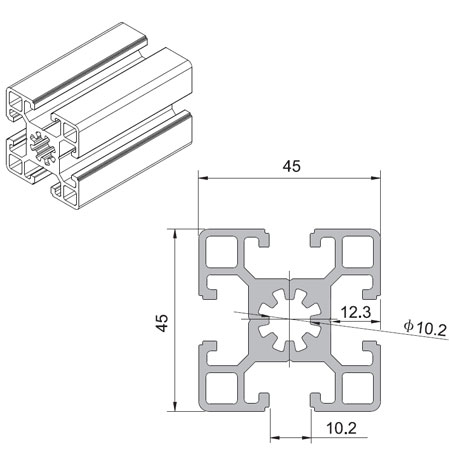T Slot Extrusion Sizes

T-Slot / V-Slot
T-Slot has been around for many years. It has matured to a solid building system using in industry and by hobby engineers to build everything from machine enclosures to CNC machines, 3D printers and robots! It is strong enough to withstand many industrial stresses and modular enough allow for universal designs.
Throat dimensions are basic. When slots are intended to be used for holding only, tolerances can be 0.0 + 0.010 inch or H12 Metric (ISO/R286); when intended for location, tolerance can be 0.0 + 0.001 inch or H8 Metric. Corners of T-Slots may be square or may be rounded or broken to the indicated maximum dimensions at the manufacturer's. These TSLOTS extrusions have slot widths of 0.322″ and are modular to each other. The inside radius is 0.187″, which makes it easy to slide drop-in T-Nuts. These extrusions are excellently suited to build sound enclosures, machine guarding, work benches, display racks and panel mount racks.
The T-slot system consists of extruded aluminum of various sizes with a “T” shaped slot on one or more of its sides. The shapes, sizes and designs may be different, but the “T” slot is common to all. The “T” slot allows of a variety of hardware to be connected to the extrusion so that complex structures can be constructed.

Types of T-Slot
There are many types of T-Slot available on the market. Some of the most common for small scale engineering include:
- V-Slot
- MakerBeam
- OpenBeam
- MicoRax
As show above, these 4 type range from 10mm to 20mm square profile. Each profile has its unique features, but all share the “T” slot function.
The profiles are not limited to square. V-slot, for example, comes in 4 sizes 20x80mm, 20x60mm, 20x40mm and 20x20mm :
Some manufactures produce larger square and other shaped profiles:
MakerBeam can fit a screw into its T-slot:
MicroRax is small, light and uses t-nuts and screws:
OpenBeam can fit a standard nut into its t-slot:
V-Slot uses t-nuts and is different from the other profiles because has “V” grooves that fit special “V” wheels and allow for easy linear motion:
Above are four different approaches to T-slot, there are in fact many more.
T-Slot / V-Slot
T-Slot has been around for many years. It has matured to a solid building system using in industry and by hobby engineers to build everything from machine enclosures to CNC machines, 3D printers and robots! It is strong enough to withstand many industrial stresses and modular enough allow for universal designs.
The T-slot system consists of extruded aluminum of various sizes with a “T” shaped slot on one or more of its sides. The shapes, sizes and designs may be different, but the “T” slot is common to all. The “T” slot allows of a variety of hardware to be connected to the extrusion so that complex structures can be constructed.
Types of T-Slot
There are many types of T-Slot available on the market. Some of the most common for small scale engineering include:
- V-Slot
- MakerBeam
- OpenBeam
- MicoRax
As show above, these 4 type range from 10mm to 20mm square profile. Each profile has its unique features, but all share the “T” slot function.

The profiles are not limited to square. V-slot, for example, comes in 4 sizes 20x80mm, 20x60mm, 20x40mm and 20x20mm :
Some manufactures produce larger square and other shaped profiles:
MakerBeam can fit a screw into its T-slot:
T Slot Extrusion Sizes Chart
MicroRax is small, light and uses t-nuts and screws:
T Slot Extrusion Sizes Tool
OpenBeam can fit a standard nut into its t-slot:
V-Slot uses t-nuts and is different from the other profiles because has “V” grooves that fit special “V” wheels and allow for easy linear motion:
T Slot Extrusion Sizes Actual
Above are four different approaches to T-slot, there are in fact many more.



